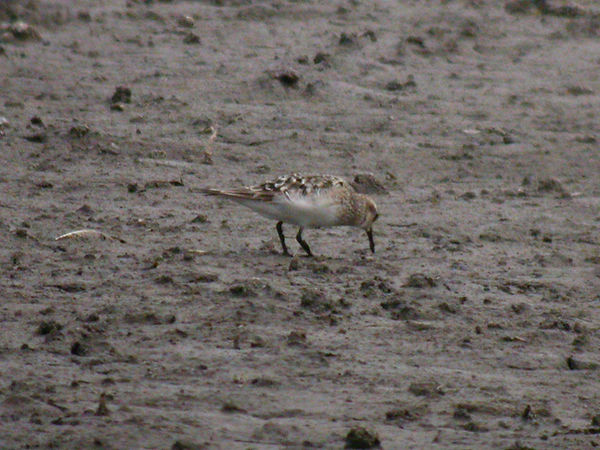
TG42 LOW-CARBON BIRDING
Baird's Sandpiper, Hickling, Rush Hills Scrape, Aug 8-12, T.E. Allwood and A.J. Kane
As Hickling now seems to be rather poor for waders compared to the heyday of a voluntarily managed Rush Hills and Swim Coots, I thought it would be a good time to relive another wader highlight - our first of two Baird's Sandpipers.
The summer holidays were in full swing and Andy and I were at Hickling, doing the scrapes for waders. I was on the Weaver's Way looking across the scrape while Andy was on the boat and in the reserve hide scanning from there. There were s few Dunlin and Ringed Plover, Little Ringed Plover and a few other bits and pieces. I was scanning right across to the back of the scrape where the reed screen is located. I noticed a small calidrid at the very back of the water and despite the distance I was immediately struck by the attenuated nature of the bird. Had been grilling everything daily for last few weeks in hope of White-rumped Sand or similar so was tuned into this feature. There was a very high chance that this would turn out to be a decent bird so I immediately called Andy Kane, to get him onto the bird as he was closer to it. As I was getting him onto the bird we both saw the it fly a short way revealing that the rump had a very dark central stripe (that seemed to continue to the tail end) and white sides, the tail-side being dark. Even though views were brief, we were sure we had a Baird's but obviously needed to see much more.
Andy took the boat to the reedscreen and was fairly quickly able to confirm a Baird's Sandpiper, with the bird even calling. He came over to the Weaver's Way and I jumped in the boat and we both headed back to the private hide. The bird was now much closer and over the next hour or so we managed to get excellent views. I took extensive field notes and some photographs and made a couple of sketches.
Description: The bird was an adult, with scattered black scapulars with narrow pale fringes showing up at long range and an absence of any 'scaly' pale-fringed pattern or the "weetabix" appearance that would indicate a juv. In addition, photos show the tertials to be rather pale and worn further confirming an adult. The bird was as small as the smallest of 15 or so Dunlin present directly alongside or maybe marginally smaller. The posture of the bird was very elongated and flat-backed with it looking compressed in cross-section, as if it had had weights placed on its back - a typical appearance of a Baird's. The bill was rather fine, all black and absolutely straight, much finer than a Little Stint's but longer, and shorter and straighter than a Dunlin's, both species available for direct comparison. The legs were also black but often mud made it difficult to observe them properly – they also appeared slightly stunted, an effect enhanced by the crouchy nature of the bird. The head was rather plain at distance and the eye stood out well. The lores were dark and there was a slight supercilium, particularly on the bird's left hand side (less obvious in the field than in the pics), and the crown was streaked a little darker. There was a hint of rufous tone on the ear coverts. The throat was pale buff / white. The upper breast and neck sides were gently streaked on a buffish ground colour and the streaks were rather abruptly cut off on the upper breast – no streaks were visible along the flank sides, for instance. This gave the bird a rather 'dark-headed' appearance in flight. The primaries clearly projected past the tertials and the tail and sometimes appeared to cross like scissor blades.
In flight the bird was very plain-winged with only a hint of a wing bar, and a rump / tail as described above. The call was a rolled, buzzy, “preeeet” and it subsequently called a few more times while we watched it. A distinctive call.
This was the first Baird's Sandpiper in TG42. The second was another adult, in 2017 that we found at Potter Heigham on almost the same date! The way things are looking at the moment, it might be a while until there's anther one in the square...


